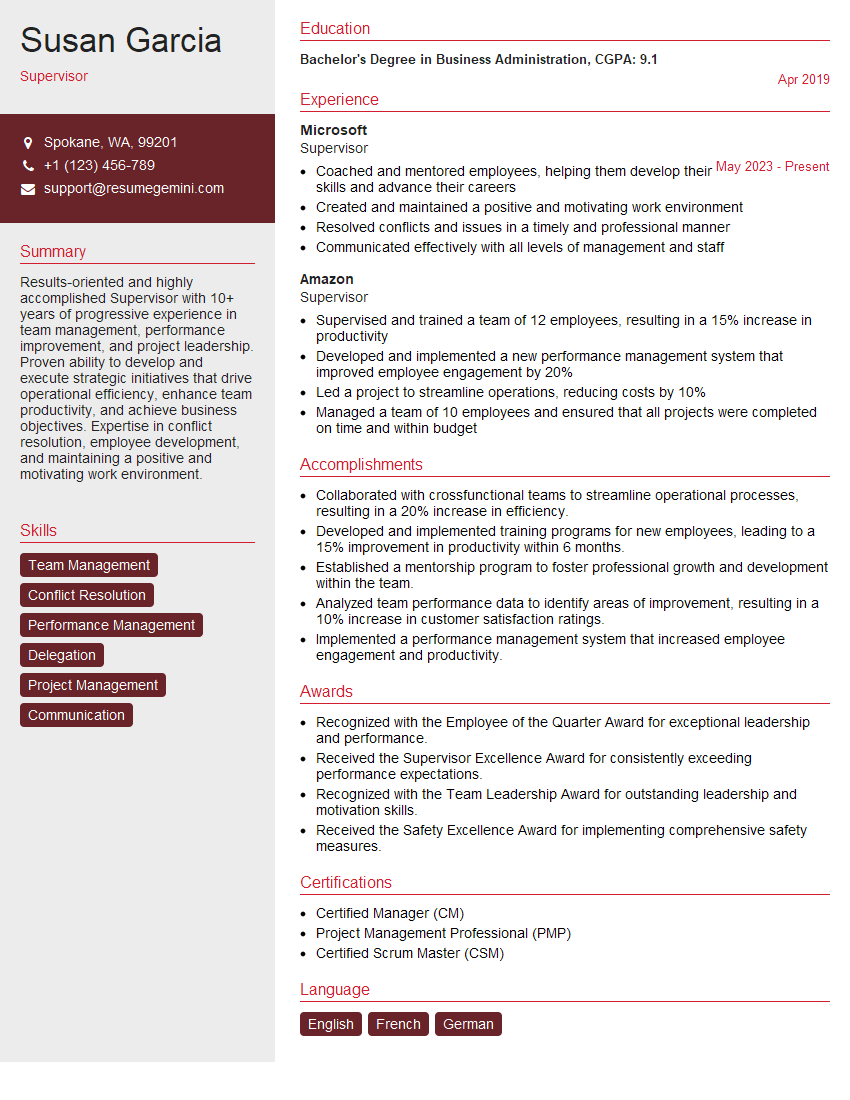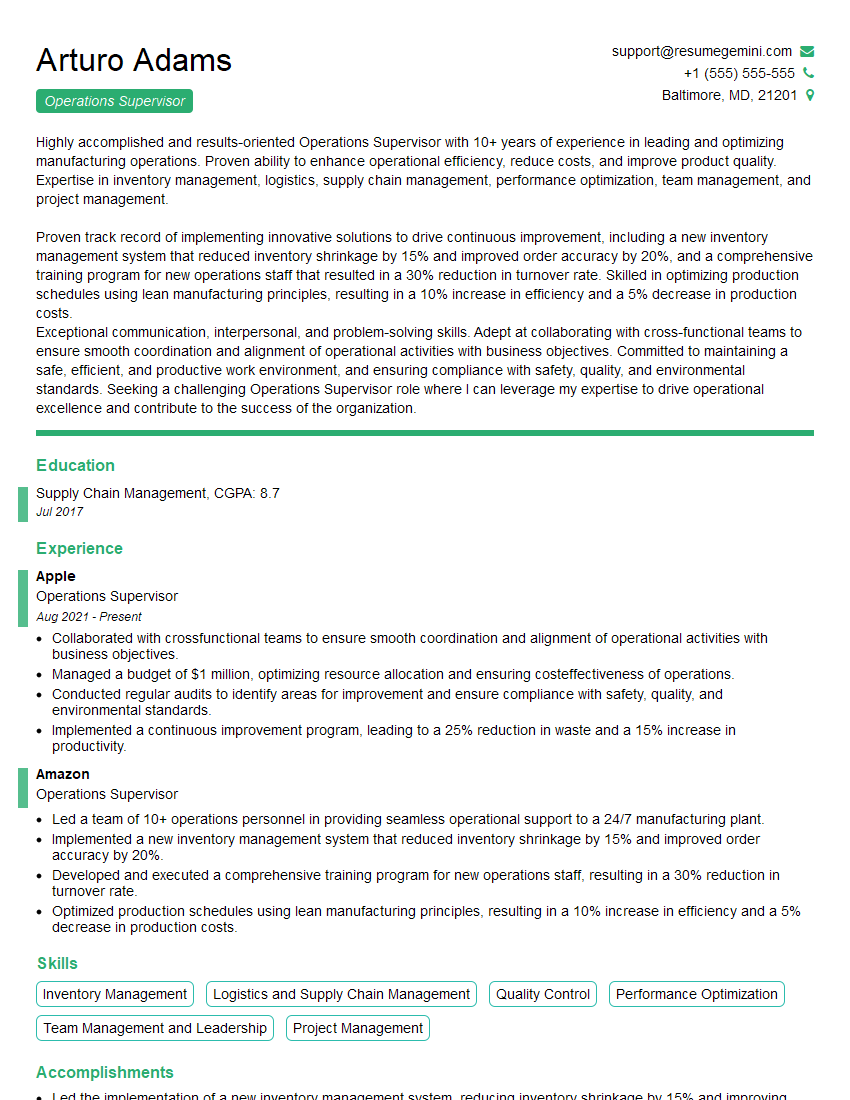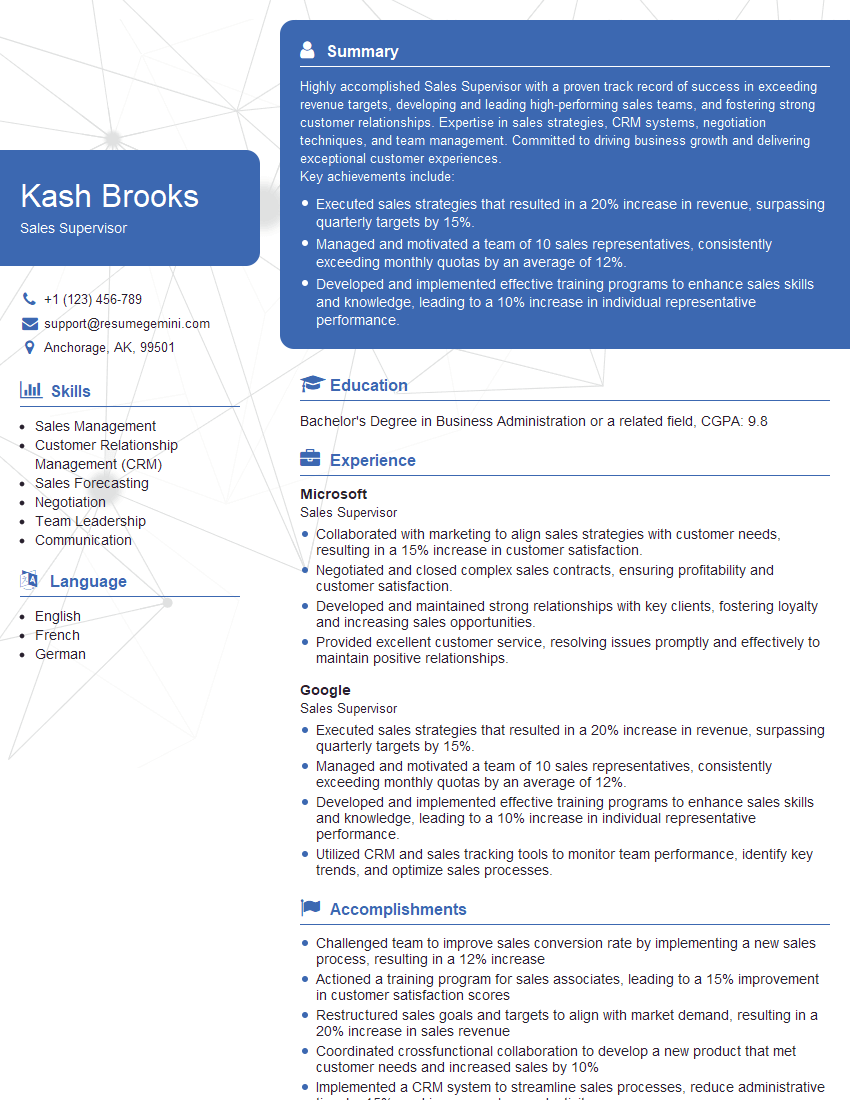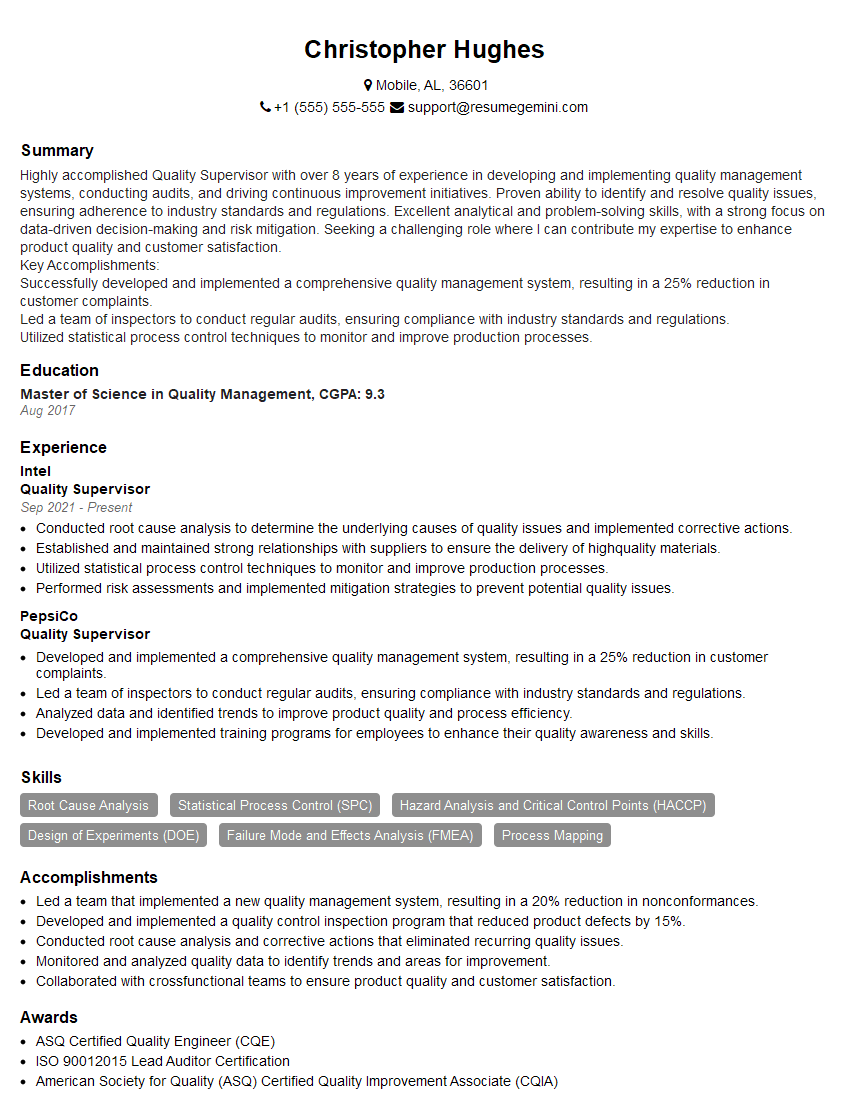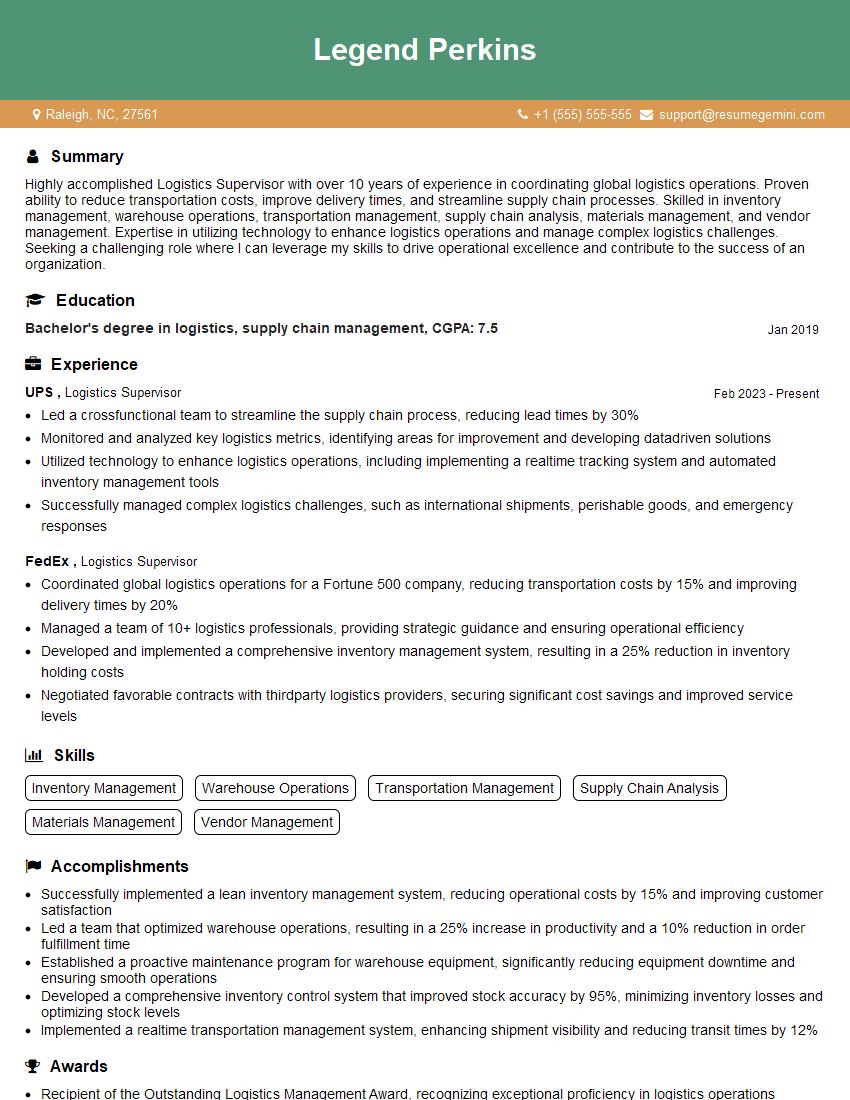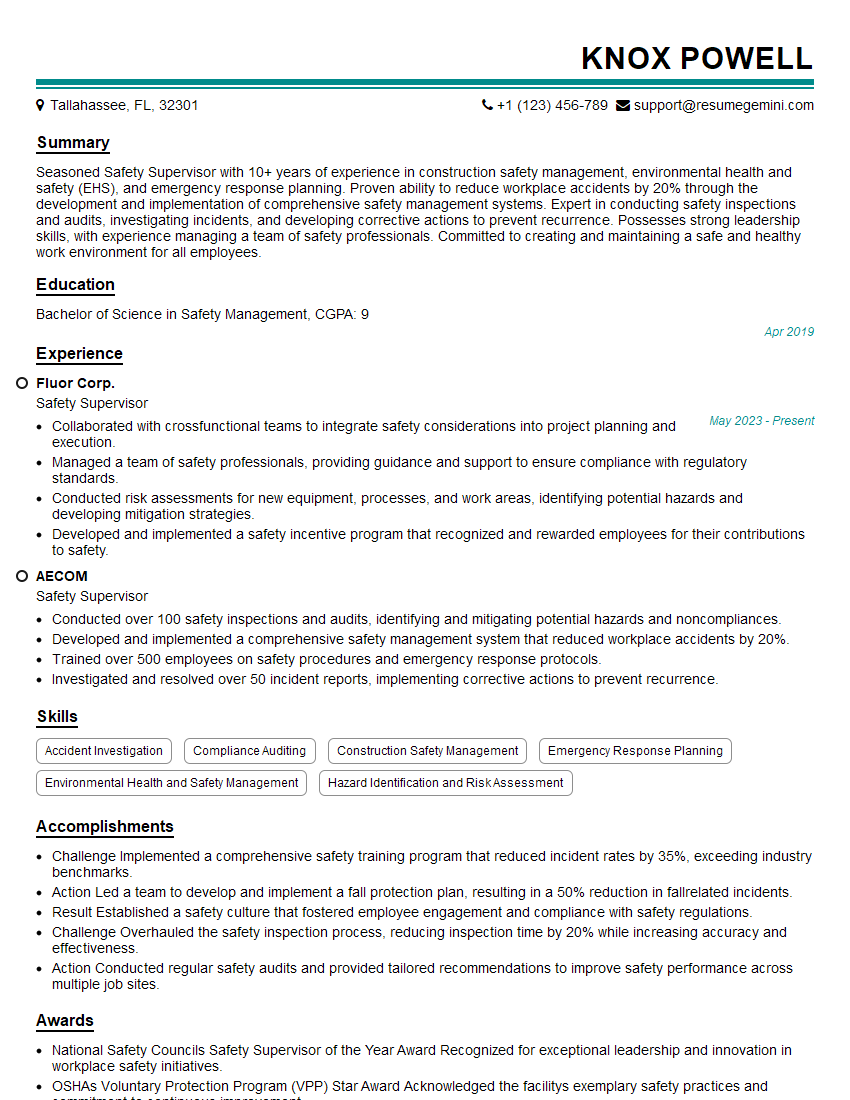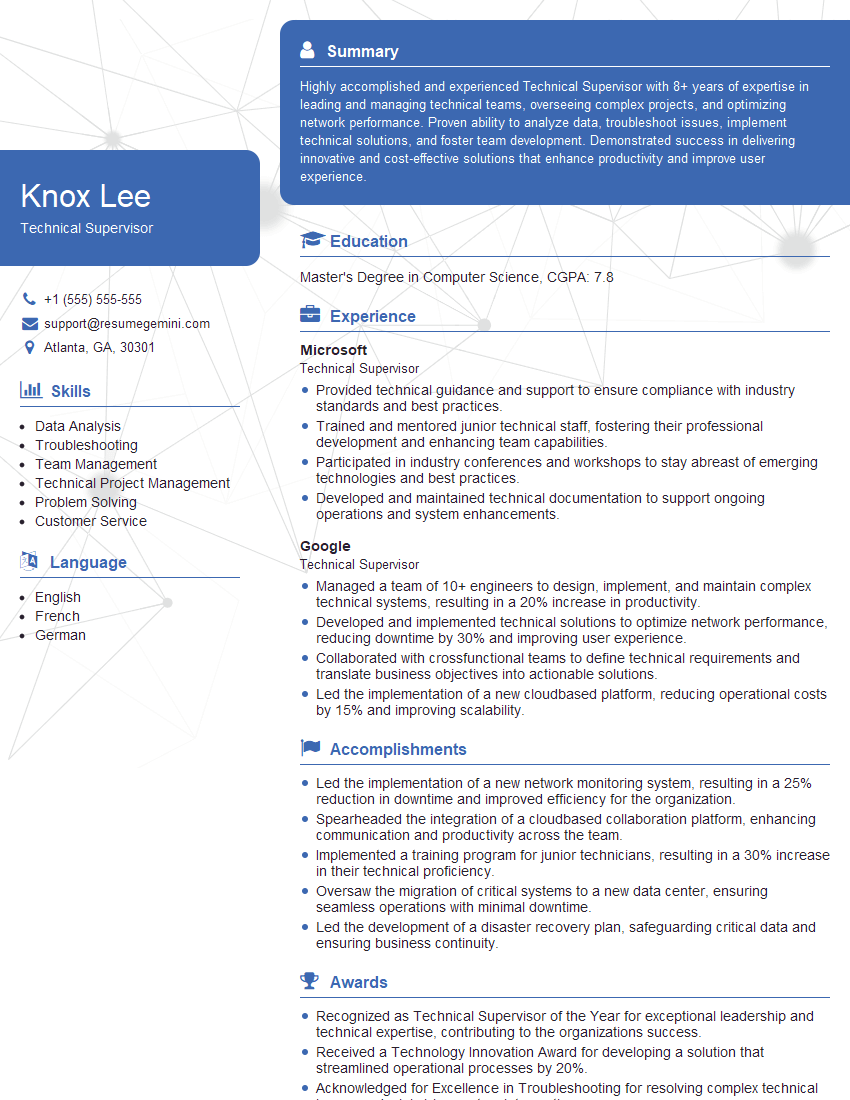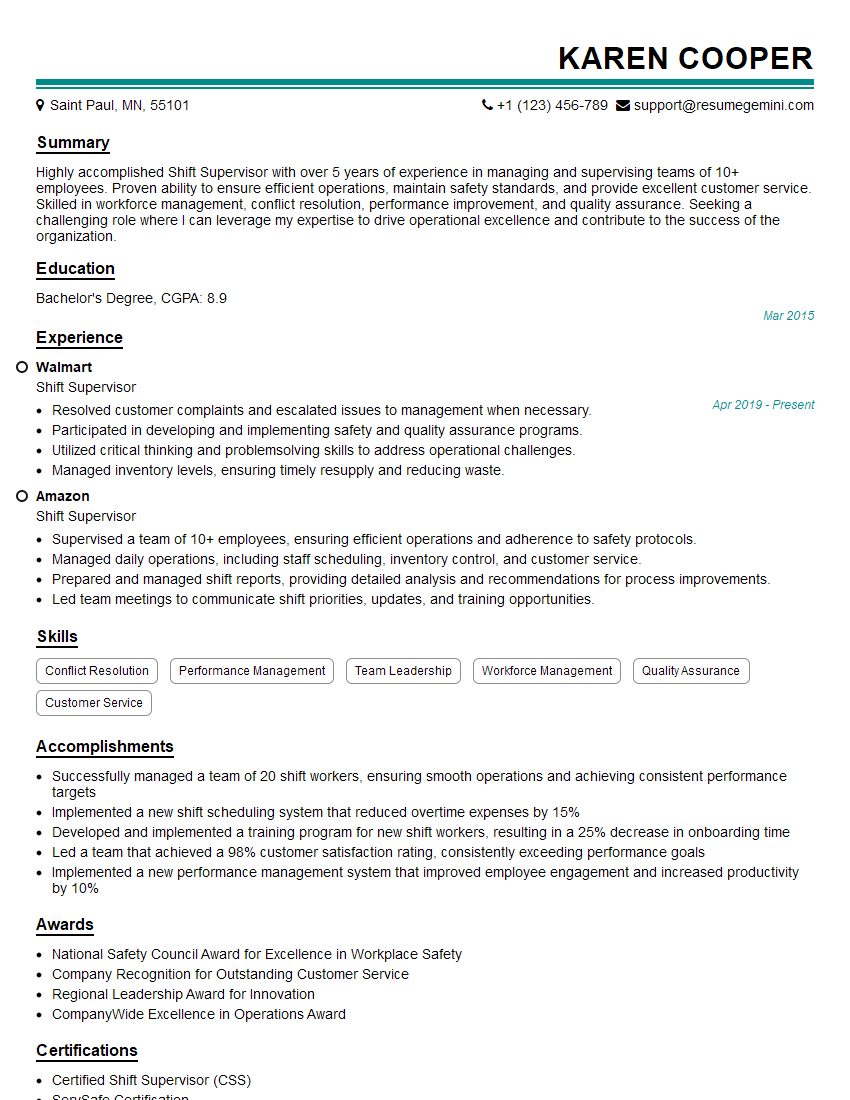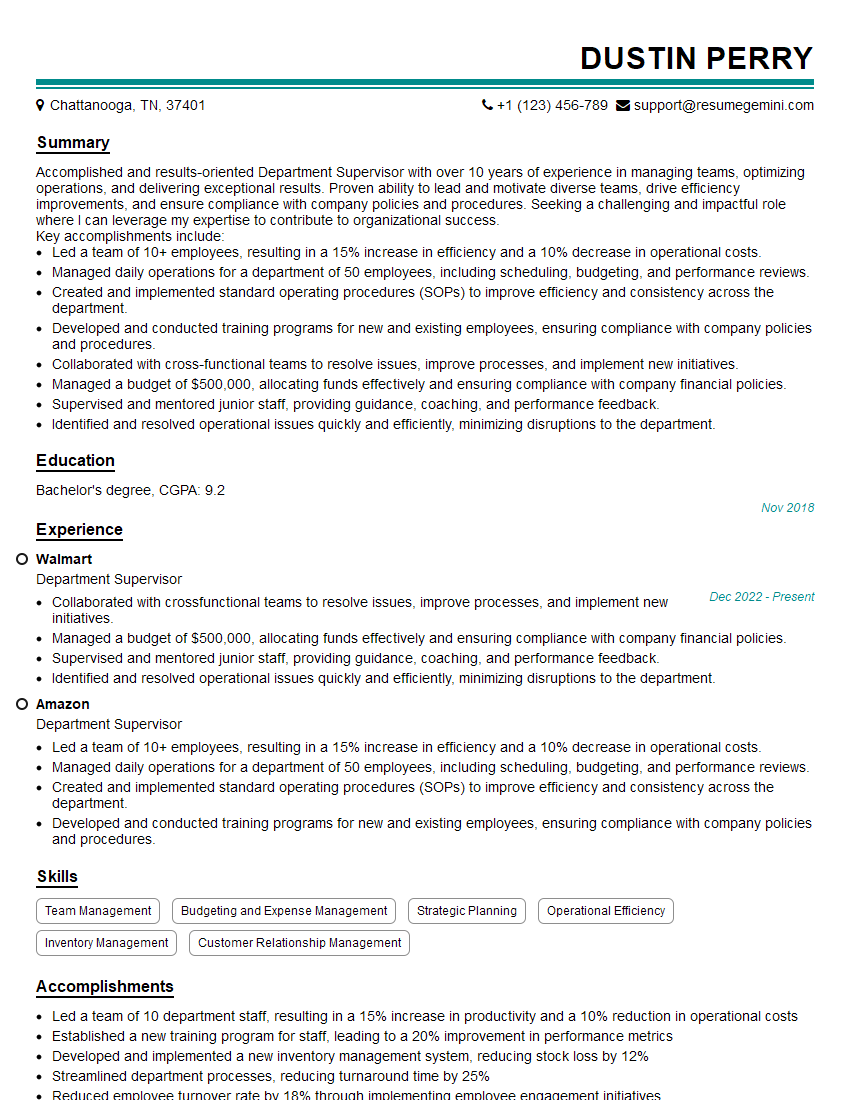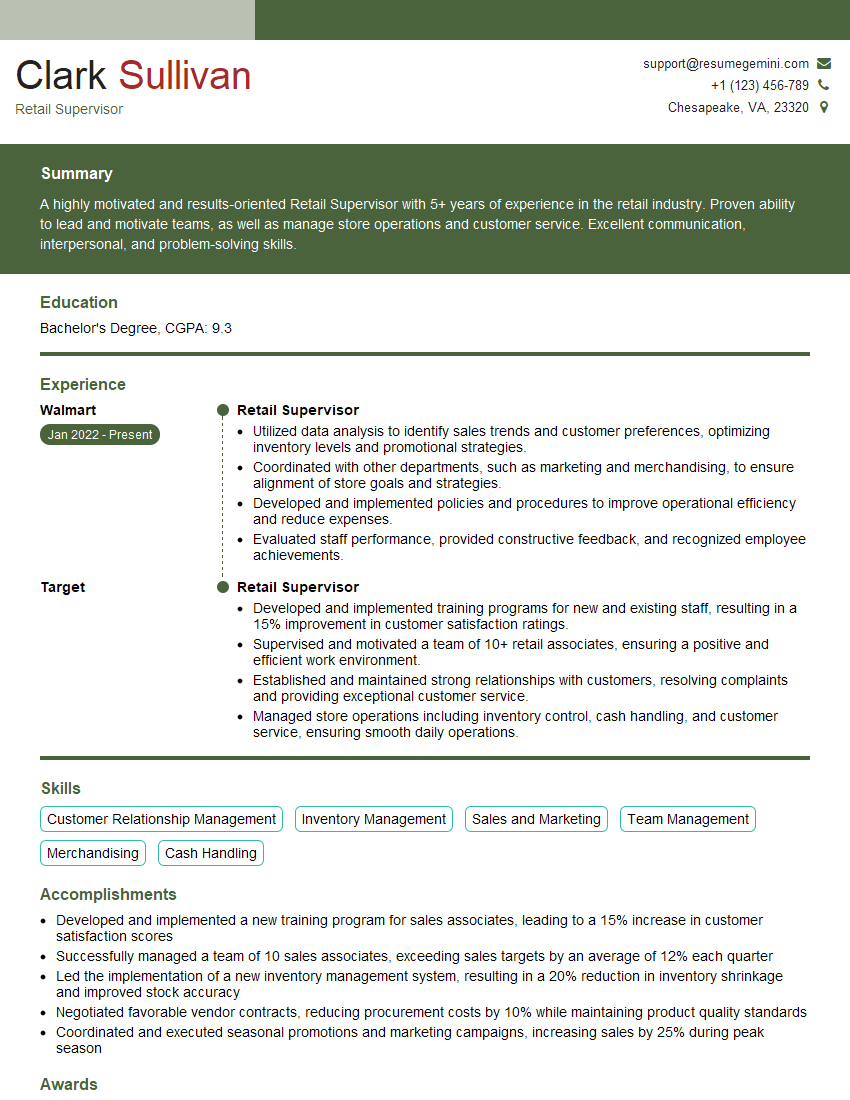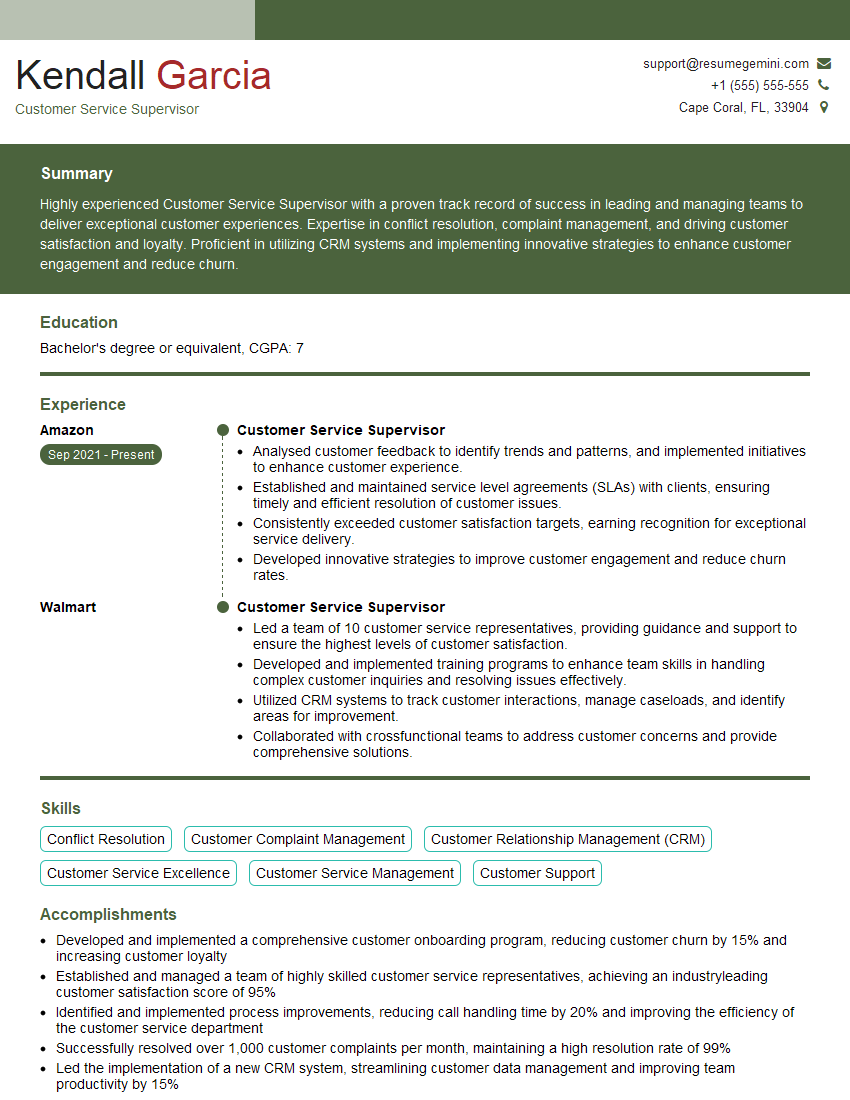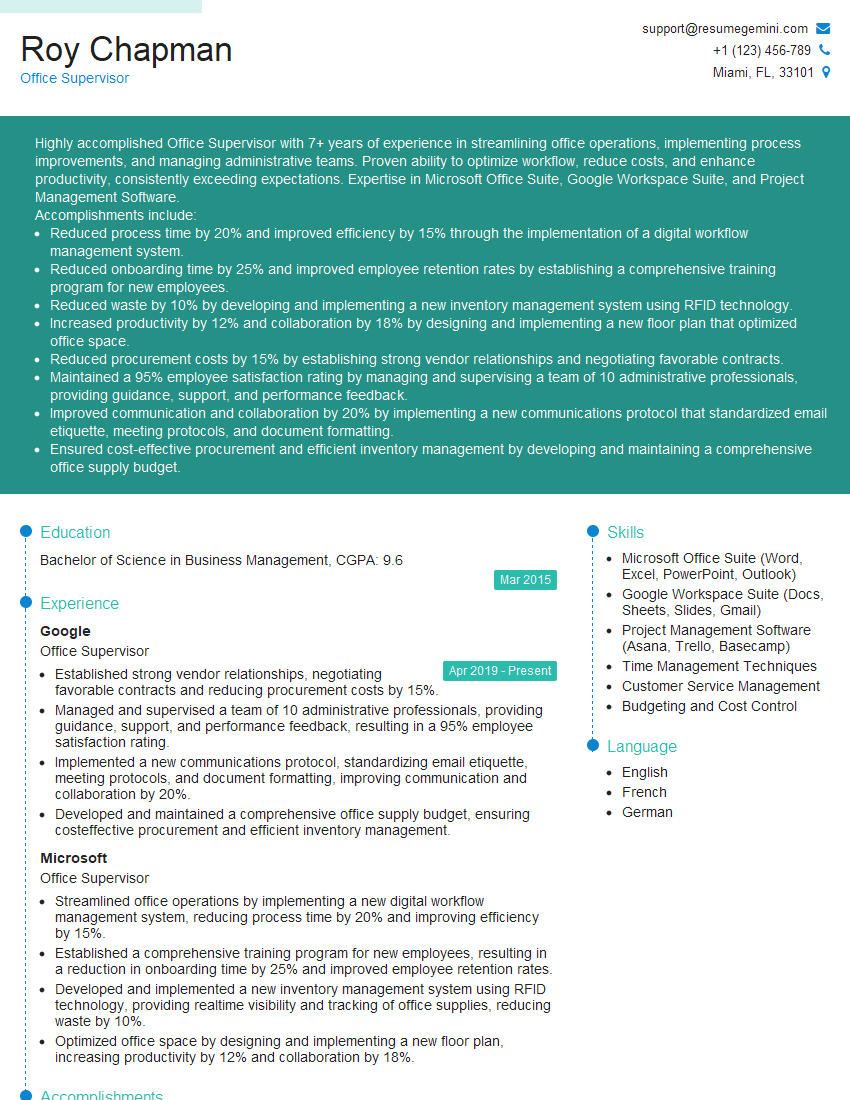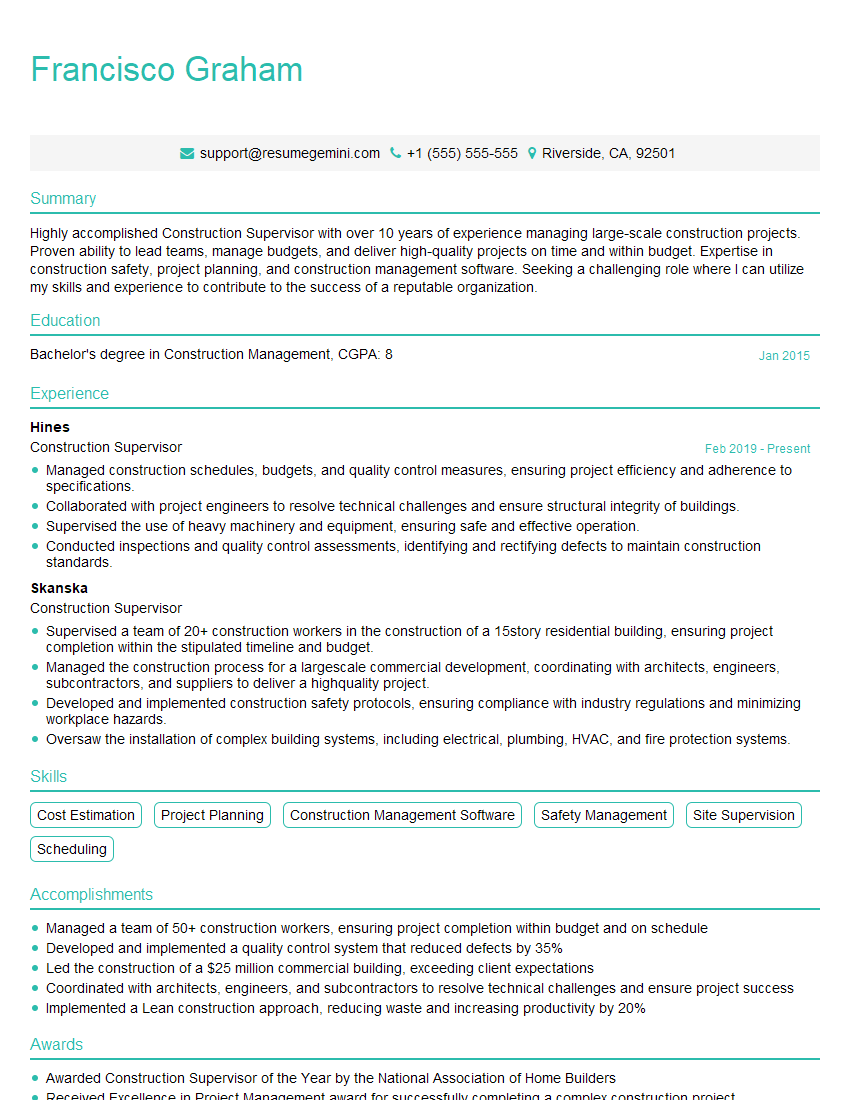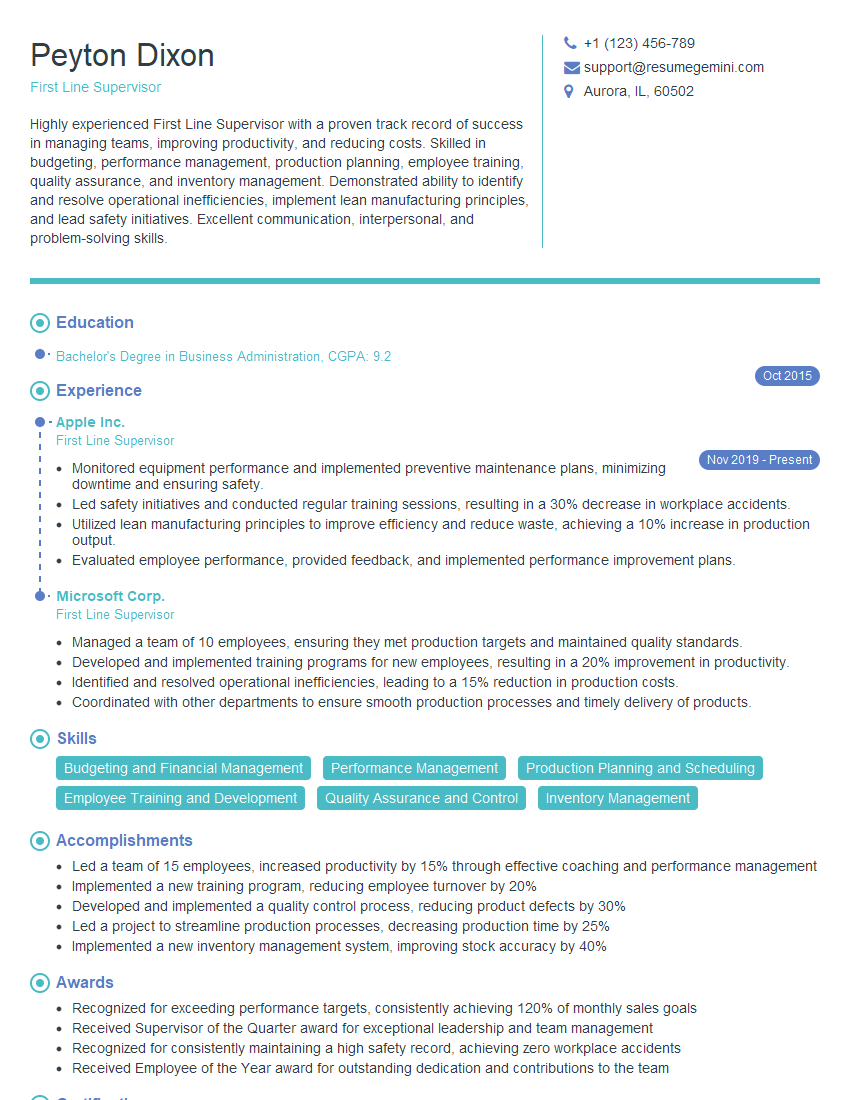Cracking a skill-specific interview, like one for Supervisor, requires understanding the nuances of the role. In this blog, we present the questions you’re most likely to encounter, along with insights into how to answer them effectively. Let’s ensure you’re ready to make a strong impression.
Questions Asked in Supervisor Interview
Q 1. Explain your experience managing and motivating a team.
Managing and motivating a team is about fostering a collaborative environment where each member feels valued, supported, and empowered to contribute their best. It’s a blend of strategic planning, clear communication, and genuine care for individual growth.
My approach involves:
- Setting clear expectations and goals: I ensure every team member understands their role, responsibilities, and how their work contributes to the overall objectives. This clarity reduces ambiguity and increases ownership.
- Open and honest communication: Regular one-on-one meetings, team meetings, and open-door policies are crucial for maintaining transparency and addressing concerns proactively. I encourage feedback, both up and down the hierarchy.
- Delegation and empowerment: I believe in delegating tasks based on individual strengths and providing the necessary resources and autonomy for team members to excel. This builds confidence and ownership.
- Recognition and appreciation: Acknowledging both individual and team successes, both big and small, fosters a positive work culture and motivates continued high performance. I believe in celebrating milestones and rewarding exceptional contributions.
- Providing opportunities for growth and development: I actively seek out training opportunities, mentorship programs, and challenging assignments to help my team members hone their skills and advance their careers. This shows investment in their future and builds loyalty.
For example, in a previous role, I implemented a peer-to-peer recognition program where team members could nominate each other for outstanding work. This boosted morale and fostered a more collaborative spirit.
Q 2. Describe your approach to conflict resolution within a team.
Conflict is inevitable in any team, but how it’s addressed determines its impact. My approach to conflict resolution focuses on finding mutually acceptable solutions while preserving the relationships within the team.
My strategy usually involves:
- Active listening: I ensure each party feels heard and understood before attempting to mediate. This involves paying close attention to both verbal and nonverbal cues.
- Identifying the root cause: Instead of focusing solely on the symptoms, I delve into the underlying issues causing the conflict. This often requires asking clarifying questions and exploring different perspectives.
- Facilitating a collaborative solution: I guide the team members towards a solution that meets the needs of everyone involved, promoting compromise and mutual respect. This might involve brainstorming various options and evaluating their pros and cons together.
- Mediating, not dictating: I act as a neutral facilitator, ensuring all voices are heard and respected, rather than imposing a solution from above. The goal is for the team to collaboratively resolve the conflict.
- Documenting the agreement: Once a solution is reached, I ensure that it’s clearly documented and agreed upon by all parties. This minimizes future misunderstandings.
For instance, I once mediated a conflict between two team members over project priorities. By facilitating open communication and helping them identify shared goals, we created a revised project plan that satisfied both individuals.
Q 3. How do you delegate tasks effectively?
Effective delegation isn’t about dumping tasks; it’s about empowering team members to take ownership and develop their skills. It’s crucial to consider individual strengths, available resources, and the overall project goals.
My approach involves:
- Assessing team member capabilities: I carefully consider each team member’s skills, experience, and capacity when assigning tasks. This ensures the right task is assigned to the right person.
- Providing clear instructions and expectations: I provide clear, concise instructions, outlining the desired outcome, deadlines, and necessary resources. Ambiguity is the enemy of effective delegation.
- Offering support and guidance: I ensure that team members have access to the necessary resources, information, and support to complete their tasks successfully. Regular check-ins help monitor progress and provide timely assistance.
- Establishing accountability: While empowering, delegation also requires accountability. I establish clear expectations for reporting progress and addressing potential roadblocks.
- Providing feedback and recognition: After the task is completed, I provide constructive feedback and acknowledge their efforts. This reinforces positive behavior and motivates future contributions.
For example, I once delegated a complex software testing project to a junior team member who showed great potential but lacked experience. By providing structured training, regular check-ins, and mentorship, they successfully completed the project, boosting their confidence and skills.
Q 4. What methods do you use to track team performance and productivity?
Tracking team performance and productivity requires a multifaceted approach that combines quantitative and qualitative data. I utilize a combination of methods to obtain a holistic view.
My methods include:
- Project management software: Tools like Jira or Asana allow for tracking task progress, deadlines, and resource allocation. This provides a clear overview of project timelines and potential bottlenecks.
- Key performance indicators (KPIs): I define relevant KPIs to measure team performance against established goals. These could include completion rates, defect rates, customer satisfaction scores, or other metrics specific to the team’s objectives.
- Regular progress reports: Team members provide regular updates on their progress, highlighting challenges and accomplishments. This provides insights into individual performance and potential areas for improvement.
- Team meetings and retrospectives: Regular meetings provide opportunities to discuss progress, address challenges, and identify areas for improvement. Retrospectives facilitate collaborative reflection on project successes and lessons learned.
- Qualitative feedback: Collecting qualitative feedback from team members, clients, and stakeholders provides valuable insights into team dynamics, morale, and overall effectiveness.
By combining quantitative data from project management tools and KPIs with qualitative feedback, I gain a comprehensive understanding of team performance and identify areas for optimization.
Q 5. How do you provide constructive feedback to team members?
Constructive feedback is crucial for fostering growth and improvement. It’s about providing specific, actionable advice that helps team members develop their skills and improve their performance. It’s not about criticism for criticism’s sake.
My approach emphasizes:
- Specificity: I avoid vague statements and instead focus on specific behaviors or actions. For example, instead of saying “You need to improve your communication,” I’d say “During the last team meeting, your explanation of the new feature was unclear. Perhaps you could use visuals next time to illustrate your points.”
- Focus on behavior, not personality: I focus on observable behaviors rather than making judgments about the individual’s character. This helps prevent defensiveness and promotes a growth mindset.
- Balance positive and negative feedback: I always start with positive reinforcement before addressing areas for improvement. This creates a more receptive environment for feedback.
- Actionable suggestions: I provide concrete suggestions for improvement, rather than simply pointing out shortcomings. This empowers team members to take ownership of their development.
- Two-way communication: I encourage a dialogue, allowing team members to ask questions, share their perspectives, and collaborate on developing an action plan for improvement.
For example, when providing feedback on a presentation, I would point out specific areas that were particularly effective, then suggest improvements on areas needing more clarity or impact.
Q 6. Describe a time you had to address a performance issue with a team member.
In a previous role, a team member consistently missed deadlines and delivered subpar work. Addressing this required a sensitive yet firm approach.
My steps were:
- Documentation: I meticulously documented all instances of missed deadlines and substandard work, including dates, specifics, and impact on the project.
- Private meeting: I scheduled a private meeting with the team member to discuss their performance, focusing on specific instances and the impact on the team and project.
- Active listening: I listened carefully to their perspective, understanding the potential underlying reasons for their performance issues. Was there a lack of understanding, resources, or support?
- Collaborative action plan: Together, we developed an action plan with specific, measurable goals, deadlines, and support strategies. This included additional training, mentoring, or adjustments to their workload.
- Regular check-ins: I scheduled regular check-in meetings to monitor progress, offer support, and provide constructive feedback. This ensured we were on track and addressed any emerging issues promptly.
- Performance improvement plan (PIP): In cases where performance doesn’t improve despite support, a formal PIP may be necessary, clearly outlining expectations and potential consequences if improvements aren’t met.
In this instance, by understanding the root cause – a lack of clarity on the project scope – and providing the necessary support, the team member’s performance significantly improved.
Q 7. How do you handle employee absences or unexpected events that disrupt workflow?
Handling employee absences or unexpected disruptions requires proactive planning and effective communication. It’s about minimizing workflow interruptions and ensuring project continuity.
My approach involves:
- Clear communication protocols: Establish clear protocols for reporting absences and unforeseen events. This ensures everyone knows how to inform the team and management of disruptions.
- Cross-training and backup plans: Cross-train team members to handle multiple tasks, minimizing reliance on any single individual. This creates a safety net for unexpected absences or emergencies.
- Prioritization and task reassignment: When absences occur, prioritize remaining tasks and reassign responsibilities based on team members’ capabilities. This ensures urgent tasks are addressed promptly.
- Flexible work arrangements: Where possible, offer flexible work arrangements (e.g., remote work) to accommodate individual needs and maintain productivity during unexpected circumstances.
- Open communication with the team: Keep the team informed about absences and any adjustments to schedules or priorities. Transparency helps alleviate anxiety and maintain team cohesion.
- Utilizing project management tools: Project management tools help track task assignments and progress, making it easier to adapt to changes in personnel or workload.
For instance, when a team member unexpectedly went on leave, we used our established cross-training procedures and project management software to efficiently reassign tasks, ensuring the project continued without significant delays.
Q 8. How do you ensure your team adheres to safety regulations and company policies?
Ensuring safety and adherence to company policies is paramount. My approach is multifaceted, focusing on proactive measures and responsive actions. First, I ensure all team members receive thorough training on all relevant safety regulations and company policies upon joining and through regular refresher courses. This training isn’t just a one-time event; it’s an ongoing process of reinforcement and adaptation to changing circumstances.
Secondly, I establish clear lines of communication where safety concerns can be voiced without fear of reprisal. We conduct regular safety meetings to discuss potential hazards, near misses, and best practices. We also use visual aids, checklists, and regular inspections to ensure compliance. For example, in my previous role, we implemented a color-coded system for identifying potential hazards, making it immediately apparent to everyone on the team. If a violation occurs, I address it swiftly and fairly, focusing on corrective action and preventing future incidents. Documentation is key here; all safety incidents are meticulously documented, analyzed, and used to improve our safety protocols.
Finally, I regularly review performance metrics related to safety, identifying areas for improvement and proactively addressing them before they become major problems. This could include things like the frequency of near misses or the number of reported safety violations. By combining proactive training, open communication, and data-driven analysis, I ensure my team prioritizes safety above all else.
Q 9. Explain your experience with performance management systems.
My experience with performance management is extensive and centered around a balanced approach that blends goal setting, regular feedback, and performance reviews. I use a system that starts with collaboratively defining clear, measurable, achievable, relevant, and time-bound (SMART) goals for each team member. This ensures everyone understands their responsibilities and how their individual contributions align with overall team objectives.
Ongoing feedback is critical. I conduct regular one-on-one meetings, not just to discuss performance but also to provide support and guidance. This fosters a culture of open communication and allows me to address potential issues early on. For instance, if a team member is struggling with a particular task, I provide coaching and resources to help them succeed. This proactive approach prevents small issues from escalating into larger performance problems.
Formal performance reviews are then used to summarize progress, identify areas of strength and weakness, and set new goals for the upcoming period. I believe in a constructive approach where feedback is balanced and focuses on both achievements and areas for improvement. The goal is always to help team members grow and develop their skills. Finally, I use a variety of performance metrics to track progress toward goals, ensuring objectivity and transparency.
Q 10. How do you identify and address training needs within your team?
Identifying training needs involves a combination of proactive planning and reactive responses. Proactively, I regularly assess the skills and knowledge of my team members against the requirements of their roles and future projects. This often involves skills gap analysis, using questionnaires, surveys, and one-on-one discussions. I also consider industry trends and emerging technologies to anticipate future needs.
Reactively, I identify training needs as issues arise. For example, if a project requires a specific software or technique, and team members lack the necessary skills, training becomes a priority. I then develop a training plan that addresses specific needs, using a combination of methods such as workshops, online courses, mentoring, and on-the-job training. For instance, if a team member needs to improve their project management skills, I might enroll them in a relevant online course and assign them to a mentor who can provide practical guidance. The effectiveness of the training is then evaluated through performance monitoring and feedback sessions.
Q 11. Describe your experience with budget management and resource allocation.
Budget management and resource allocation require a strategic and disciplined approach. I begin by understanding the overall budget and allocating funds based on priorities aligned with organizational goals. This involves careful analysis of projected expenses, identifying cost savings, and justifying budget requests with data-driven projections. I use various budgeting techniques like zero-based budgeting or incremental budgeting, adapting them to the specific needs of the project or team.
Resource allocation goes beyond just financial resources. It also includes time, personnel, equipment, and other essential elements. I strive for optimal allocation by considering factors such as project timelines, team member skills, and availability of resources. I utilize project management software and tools to track resource utilization and ensure efficient allocation. For instance, I use Gantt charts to visualize project timelines and resource allocation, allowing for proactive adjustments and preventing resource conflicts. Regular monitoring and reporting are crucial to identify any deviations from the budget and to implement corrective actions.
Q 12. How do you prioritize tasks and manage deadlines in a fast-paced environment?
Prioritizing tasks and managing deadlines in a fast-paced environment requires a systematic approach. I typically use a combination of techniques, including prioritization matrices (like Eisenhower Matrix), project management methodologies (like Agile or Scrum), and task management tools. The Eisenhower Matrix helps me categorize tasks based on urgency and importance, enabling me to focus on the most critical items first. Agile methodologies provide a framework for iterative development and flexible task management.
Task management tools, such as Trello or Asana, allow me to track progress, assign responsibilities, and monitor deadlines. Communication is key; I maintain open communication with the team, regularly updating them on priorities and any changes to deadlines. Proactive risk management is also crucial; identifying potential roadblocks in advance allows me to develop contingency plans and avoid delays. For example, if I anticipate a potential delay in the delivery of a critical component, I’ll proactively communicate this to stakeholders and explore alternative solutions.
Q 13. What strategies do you use to foster a positive and collaborative team environment?
Fostering a positive and collaborative team environment is essential for success. I start by building strong relationships with team members, creating a safe and inclusive space where everyone feels valued and respected. This includes actively listening to their concerns, celebrating achievements, and providing regular constructive feedback. Team-building activities, both formal and informal, play a vital role. These activities can range from simple team lunches to more structured events focused on collaboration and problem-solving.
I also encourage open communication and knowledge sharing among team members. Regular team meetings, brainstorming sessions, and informal discussions allow for the free exchange of ideas and build camaraderie. I promote a culture of mutual respect and appreciation, acknowledging individual contributions and celebrating collective successes. Clear roles and responsibilities are essential to prevent confusion and promote efficiency. By fostering a supportive and collaborative atmosphere, I empower team members to work together effectively and achieve common goals.
Q 14. How do you communicate effectively with team members at all levels?
Effective communication is fundamental to my leadership style. I adapt my communication style to the audience and the context. When communicating with senior management, I provide concise, data-driven reports and updates, highlighting key accomplishments and challenges. With team members, I prefer a more open and collaborative style, encouraging feedback and participation in discussions. I ensure communication is clear, concise, and easily understood, avoiding jargon and technical terms whenever possible.
I use a variety of communication channels to ensure information reaches everyone effectively. This includes regular team meetings, email updates, project management software, and instant messaging tools. For complex or sensitive issues, I prefer face-to-face communication to ensure clarity and foster strong relationships. Active listening is crucial, allowing me to understand different perspectives and address concerns promptly. Regular feedback loops help me understand how effectively my communication is being received and adjust my approach as needed.
Q 15. Describe your experience with problem-solving and decision-making in a supervisory role.
Problem-solving and decision-making are crucial aspects of my supervisory experience. I approach challenges using a structured, data-driven method. First, I clearly define the problem, gathering information from all relevant sources – team members, documentation, performance data, etc. Then, I analyze the situation, identifying potential root causes and considering various contributing factors. This often involves brainstorming sessions with my team to leverage collective intelligence. Next, I evaluate possible solutions, weighing their pros and cons against the overall organizational goals and potential risks. Finally, I implement the chosen solution, monitoring its effectiveness and making adjustments as needed. For instance, when faced with a significant drop in team productivity, I initiated a series of one-on-one meetings to understand individual challenges, leading to the implementation of new training programs and improved resource allocation, which resulted in a 15% increase in productivity within two months.
My decision-making process is always transparent and inclusive. I believe in empowering my team by involving them in the decision-making process whenever possible. This fosters a sense of ownership and commitment to the solutions implemented.
Career Expert Tips:
- Ace those interviews! Prepare effectively by reviewing the Top 50 Most Common Interview Questions on ResumeGemini.
- Navigate your job search with confidence! Explore a wide range of Career Tips on ResumeGemini. Learn about common challenges and recommendations to overcome them.
- Craft the perfect resume! Master the Art of Resume Writing with ResumeGemini’s guide. Showcase your unique qualifications and achievements effectively.
- Don’t miss out on holiday savings! Build your dream resume with ResumeGemini’s ATS optimized templates.
Q 16. How do you stay organized and manage your time effectively?
Staying organized and managing my time effectively is paramount in a supervisory role. I utilize a combination of digital and traditional methods. I rely heavily on project management tools like Asana or Trello to track tasks, deadlines, and individual team member assignments. These tools allow for clear visualization of project progress and facilitate effective delegation. I also maintain a detailed calendar, blocking out time for specific tasks and meetings, ensuring sufficient time for both strategic planning and operational responsibilities. Furthermore, I prioritize tasks based on urgency and importance, using frameworks like the Eisenhower Matrix (urgent/important) to effectively manage my workload. Regular time blocking for focused work, away from interruptions, is essential for deep work and strategic thinking. Finally, I conduct regular reviews of my schedule and adjust it based on changing priorities. This proactive approach ensures I remain efficient and productive.
Q 17. How do you handle pressure and stressful situations?
Handling pressure and stressful situations effectively requires a calm and systematic approach. My strategy involves first assessing the situation objectively, identifying the core issues contributing to the stress. Then, I break down complex problems into smaller, manageable tasks, delegating where appropriate and focusing my energy on the most critical elements. Effective communication is key during stressful situations; I maintain open and honest dialogue with my team, ensuring they are informed and involved. I also prioritize self-care, ensuring I maintain a work-life balance to avoid burnout. This includes regular breaks, exercise, and pursuing hobbies outside of work. For example, during a critical project launch with tight deadlines, I implemented daily stand-up meetings to proactively identify and address potential roadblocks, keeping the team informed and motivated. This prevented minor issues from escalating into major crises.
Q 18. What is your experience with employee relations and disciplinary actions?
My experience with employee relations centers around fostering a positive and productive work environment. I believe in proactive communication and open dialogue, addressing concerns promptly and fairly. I regularly meet with team members to discuss their progress, challenges, and aspirations. In cases requiring disciplinary action, I follow a clear and consistent process, adhering to company policies and relevant labor laws. This involves documenting all incidents, providing written warnings, and offering opportunities for improvement. Fairness and consistency are paramount to maintain trust and morale within the team. I believe in providing constructive feedback and coaching to help employees grow and develop. For example, in one instance, an employee consistently missed deadlines. Instead of immediate termination, I engaged in a series of performance improvement conversations, documenting the issues and setting clear expectations. With support and training, the employee significantly improved their performance.
Q 19. Describe your experience using performance management software or tools.
I have extensive experience utilizing performance management software, primarily using systems like BambooHR and Workday. These platforms allow me to track individual and team performance, set goals, conduct performance reviews, and provide constructive feedback. The software facilitates the efficient collection and analysis of performance data, helping identify areas of strength and weakness within the team. I leverage the reporting features to identify trends and patterns, which aids in identifying training needs and improving overall team performance. For instance, using Workday’s performance review module, I created standardized review forms and performance metrics, ensuring consistency and objectivity in evaluating employee contributions.
Q 20. How do you adapt your management style to different team members and situations?
Adapting my management style to different team members and situations is crucial for effective leadership. I believe in a flexible approach, recognizing that a one-size-fits-all management style is ineffective. I tailor my approach based on individual team members’ personalities, work styles, and skill levels. For example, some team members thrive with detailed instructions and close supervision, while others prefer more autonomy and independence. I use a combination of coaching, mentoring, and delegating to best support each individual’s growth and development. Additionally, I adjust my communication style based on the situation. In high-pressure situations, I provide clear and concise directives; during collaborative projects, I encourage open communication and brainstorming.
Q 21. Explain your understanding of labor laws and regulations.
My understanding of labor laws and regulations is comprehensive. I am familiar with federal and state laws related to wages, hours, overtime, workplace safety, discrimination, harassment, and employee rights. I ensure all my actions and decisions comply with these regulations. I stay updated on any changes in legislation through professional development courses and industry publications. This knowledge is crucial in ensuring fair and equitable treatment of all employees, mitigating legal risks, and maintaining a compliant workplace. For example, I ensure accurate record-keeping of employee hours to comply with wage and hour laws, and I am proactive in providing training on workplace safety and harassment prevention.
Q 22. How do you ensure compliance with company policies and procedures?
Ensuring compliance with company policies and procedures is paramount for maintaining a productive and ethical work environment. My approach involves a multi-pronged strategy focusing on communication, training, and consistent monitoring.
- Clear Communication: I begin by ensuring every team member has readily accessible and understandable copies of all relevant policies and procedures. This includes regular reviews and updates to address any changes.
- Comprehensive Training: I conduct regular training sessions, incorporating interactive elements like quizzes and case studies, to reinforce understanding and address specific questions. This ensures everyone is not just aware of the policies, but understands their practical implications.
- Consistent Monitoring and Feedback: I regularly monitor team activities to identify any potential compliance issues. This isn’t about catching mistakes, but proactively guiding the team to best practices. Feedback is delivered constructively, focusing on learning and improvement.
- Leading by Example: Compliance starts with me. I consistently model expected behaviors and adhere to all company policies, demonstrating the importance of compliance to my team.
For example, in a previous role, we implemented a new data security protocol. I organized training sessions that included interactive scenarios, simulating real-world data breaches, and allowing team members to practice the new protocol in a safe environment. This proactive approach resulted in a seamless transition and significantly reduced the risk of non-compliance.
Q 23. Describe your experience with project management methodologies.
My experience with project management methodologies is extensive, encompassing Agile, Waterfall, and hybrid approaches. I tailor my approach to the specific project requirements and team dynamics.
- Agile: I’ve successfully implemented Scrum and Kanban methodologies in several projects, emphasizing iterative development, continuous feedback, and flexibility. This allows for quick adaptation to changing requirements and maximizes team engagement.
- Waterfall: In situations requiring a more structured and sequential approach, I have successfully utilized the Waterfall methodology, meticulously planning and executing each phase to ensure deliverables align with project objectives.
- Hybrid: Often, a blend of Agile and Waterfall techniques proves most effective. For example, using Waterfall for the initial planning phases and transitioning to Agile for the development and testing phases ensures efficient resource allocation and timely delivery.
In one project, we initially adopted a Waterfall approach for the initial design phase due to the high level of regulatory compliance requirements. However, during the development phase, we transitioned to an Agile approach to allow for greater flexibility and responsiveness to evolving customer needs. This hybrid approach resulted in a successful project launch on time and within budget.
Q 24. How do you measure the success of your team’s performance?
Measuring team performance goes beyond simply tracking individual output. I use a combination of qualitative and quantitative metrics to gain a comprehensive understanding of our success.
- Key Performance Indicators (KPIs): I identify and track relevant KPIs that align with overall team objectives. This might include metrics such as project completion rates, customer satisfaction scores, and efficiency gains.
- Regular Performance Reviews: I conduct regular one-on-one meetings with each team member to discuss progress, challenges, and areas for improvement. These reviews provide valuable qualitative feedback and insights.
- Team Collaboration and Effectiveness: I assess team dynamics, communication efficiency, and problem-solving skills. Effective teamwork is crucial for achieving common goals.
- Continuous Improvement: I encourage feedback from the team itself and actively seek opportunities to improve processes and methodologies.
For instance, in a previous role, we established a system of tracking project completion rates and customer feedback. By analyzing this data, we identified bottlenecks in our process and implemented improvements that led to a 15% increase in project efficiency and a 10% improvement in customer satisfaction.
Q 25. What are your strengths and weaknesses as a supervisor?
My strengths lie in my ability to foster collaboration, provide clear direction, and build strong relationships with my team members. I am a strong communicator and actively listen to understand different perspectives. I believe in empowering my team to take ownership and initiative.
A weakness I am actively working on is delegating tasks effectively. While I can effectively manage multiple projects, I sometimes find it challenging to completely relinquish control, which can hinder team member growth and development. To address this, I am focusing on developing more trust in my team’s abilities and practicing more effective delegation techniques.
Q 26. How do you handle difficult conversations with employees?
Handling difficult conversations requires empathy, clear communication, and a structured approach. I follow a process that emphasizes active listening, providing constructive feedback, and seeking solutions collaboratively.
- Preparation: I prepare for the conversation by clearly outlining the issue and potential solutions.
- Active Listening: I prioritize listening to the employee’s perspective without interruption or judgment.
- Constructive Feedback: I deliver feedback in a calm and respectful manner, focusing on specific behaviors rather than making personal attacks.
- Collaborative Problem-Solving: I work with the employee to develop a plan for improvement and support their growth.
For example, if an employee consistently misses deadlines, I would begin by understanding the root cause – is it a lack of resources, unclear expectations, or personal challenges? Once the root cause is identified, we can work together to find a solution, such as providing additional training, adjusting deadlines, or offering support.
Q 27. Describe your experience with mentoring and developing team members.
Mentoring and developing team members is a passion of mine. I believe in fostering a supportive and challenging environment where individuals can reach their full potential. My approach involves providing regular feedback, identifying opportunities for growth, and empowering team members to take on new challenges.
- Regular Check-ins: I schedule regular one-on-one meetings to discuss career goals, provide constructive feedback, and identify areas for improvement.
- Delegation and Empowerment: I delegate tasks that challenge individuals and provide opportunities for skill development.
- Training and Development: I actively seek out and provide opportunities for professional development, such as workshops, conferences, or online courses.
- Mentorship: I serve as a mentor to individuals within my team, providing guidance and support as they navigate their careers.
In my previous role, I mentored a junior team member who was struggling with public speaking. By providing regular coaching, encouraging participation in presentations, and offering constructive feedback, this individual transformed from being hesitant to a confident presenter.
Q 28. What are your salary expectations for this role?
My salary expectations for this role are in the range of [Insert Salary Range] annually. This is based on my experience, skills, and the requirements of this position. I am open to discussing this further and am confident that my contributions will quickly exceed the value of this compensation.
Key Topics to Learn for Supervisor Interview
- Leadership Styles & Team Management: Understand different leadership approaches (transformational, transactional, servant leadership) and their practical application in motivating and managing teams. Consider how you’d handle conflict resolution and performance management.
- Delegation & Accountability: Learn effective strategies for delegating tasks, setting clear expectations, and holding team members accountable for their work. Practice explaining how you ensure projects stay on track and deadlines are met.
- Communication & Collaboration: Explore best practices for clear and concise communication, both written and verbal. Practice explaining how you foster a collaborative team environment and facilitate effective communication among team members.
- Performance Evaluation & Feedback: Familiarize yourself with different methods for conducting performance evaluations and providing constructive feedback. Practice giving and receiving feedback professionally and constructively.
- Problem-Solving & Decision-Making: Develop your ability to identify problems, analyze root causes, and implement effective solutions. Be prepared to discuss your approach to decision-making, particularly in high-pressure situations.
- Project Management & Planning: Understand the principles of project management, including planning, scheduling, and monitoring progress. Be ready to discuss your experience with project management methodologies and tools.
- Strategic Thinking & Goal Setting: Practice articulating your approach to strategic thinking and goal setting, both for individual team members and the team as a whole. Be prepared to discuss how you align team goals with overall organizational objectives.
Next Steps
Mastering the skills required for a Supervisor role significantly enhances your career prospects and opens doors to increased responsibility and leadership opportunities. A strong resume is crucial for showcasing these skills effectively to potential employers. To increase your chances of getting noticed by Applicant Tracking Systems (ATS) and recruiters, crafting an ATS-friendly resume is essential. We highly recommend leveraging ResumeGemini to build a professional and impactful resume tailored to your experience and the specific requirements of Supervisor roles. Examples of resumes tailored to Supervisor positions are available within ResumeGemini’s resources.
Explore more articles
Users Rating of Our Blogs
Share Your Experience
We value your feedback! Please rate our content and share your thoughts (optional).
What Readers Say About Our Blog
Hello,
We found issues with your domain’s email setup that may be sending your messages to spam or blocking them completely. InboxShield Mini shows you how to fix it in minutes — no tech skills required.
Scan your domain now for details: https://inboxshield-mini.com/
— Adam @ InboxShield Mini
Reply STOP to unsubscribe
Hi, are you owner of interviewgemini.com? What if I told you I could help you find extra time in your schedule, reconnect with leads you didn’t even realize you missed, and bring in more “I want to work with you” conversations, without increasing your ad spend or hiring a full-time employee?
All with a flexible, budget-friendly service that could easily pay for itself. Sounds good?
Would it be nice to jump on a quick 10-minute call so I can show you exactly how we make this work?
Best,
Hapei
Marketing Director
Hey, I know you’re the owner of interviewgemini.com. I’ll be quick.
Fundraising for your business is tough and time-consuming. We make it easier by guaranteeing two private investor meetings each month, for six months. No demos, no pitch events – just direct introductions to active investors matched to your startup.
If youR17;re raising, this could help you build real momentum. Want me to send more info?
Hi, I represent an SEO company that specialises in getting you AI citations and higher rankings on Google. I’d like to offer you a 100% free SEO audit for your website. Would you be interested?
Hi, I represent an SEO company that specialises in getting you AI citations and higher rankings on Google. I’d like to offer you a 100% free SEO audit for your website. Would you be interested?
good
